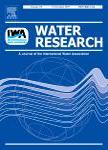版权所有:内蒙古大学图书馆 技术提供:维普资讯• 智图
内蒙古自治区呼和浩特市赛罕区大学西街235号 邮编: 010021

作者机构:Tongji Univ Coll Environm Sci & Engn State Key Lab Pollut Control & Resource Reuse Shanghai 200092 Peoples R China Shanghai Inst Pollut Control & Ecol Secur Shanghai 200092 Peoples R China
出 版 物:《WATER RESEARCH》 (水研究)
年 卷 期:2018年第144卷
页 面:763-773页
核心收录:
学科分类:0830[工学-环境科学与工程(可授工学、理学、农学学位)] 08[工学] 0815[工学-水利工程]
基 金:National Hi-Tech Research and Development Program of China (863) [2011AA060902] Chinese Key Special Program on the S&T for the Pollution Control and Treatment of Water Bodies [2015ZX07306001-03]
主 题:Phosphorus recovery AAO-SBSPR process Operational strategy P mass balance Sludge retention time Nutrient removal
摘 要:A novel MO-SBSPR (Anaerobic-Anoxic-Oxic/Sequencing Batch Sidestream Phosphorus Recovery) process was developed for phosphorus (P) recovery and nutrient removal from municipal wastewater. Meanwhile, an operational strategy based on the P mass balance for the process was proposed, where P recovery rate was coupled with sludge retention time (SRT) so as to reduce the impact of P recovery on P content in activated sludge and maintain a stable operation of the process. The results show that the proposed operational strategy is helpful for the stable operation of the AAO-SBSPR process and up to 65% of the influent P was recovered with the phosphate removal efficiency of 99.1%. Both P recovery and extended SRT had limited influence on the P release and uptake rates of polyphosphate accumulating organisms (PAOs). The results of high-throughput sequencing analysis indicated that the relative abundance of Accumulibacter increased while SRT was extended under high P recovery rate. Moreover, significant promotion of simultaneous nitrogen removal and P uptake was observed, where the ratio of anoxic P uptake to the total P uptake of the whole process increased from 41.7% in the AAO process to 77.5% in the AAO-SBSPR process, combined with the increase of total nitrogen (TN) removal efficiency from 71.9% to 80.4%. The P recovery process is also beneficial for the reduction of sludge production and nitrification process as SRT was extended for high P recovery rate. Overall, the AAO-SBSPR process together with the operational strategy proposed in this study provides a promising and practical alternative for P recovery from municipal wastewater. (C) 2018 Elsevier Ltd. All rights reserved.